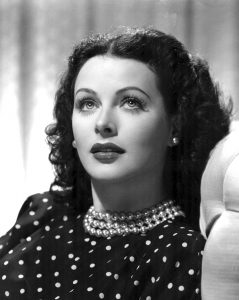Inspirational women: Hedy Lamarr
29/03/22
Connected to Wi-Fi? You might have to thank Hedy Lamarr for that: the Hollywood actress was a co-inventor of the technology that would become the basis of today’s Wi-Fi, Bluetooth and GPS.

Hedy Lamarr, née Hedwig Eva Kiesler, was born in Vienna, Austria on 9 November, 1914. Technically inclined as a child, Hedy would often take apart and reassemble objects she found around the house, such as her music box, to understand how these machines operated.
Discovered by director Max Reinhardt at the young age of 16, Hedy studied acting under his guidance in Berlin and landed her first film role in a German film called Geld auf der Straβe (“Money on the Street”). However, the start of her career as an actress meant that her inventive genius would be cast into the shade, as people would come to recognise her for her beauty and not her ingenuity.
After a failed marriage to the Austrian munitions dealer Fritz Mandl, Hedy flees to London in 1937, bringing with her the knowledge gained from dinner-table conversations about wartime weaponry. While in London, Hedy is introduced to Louis B. Mayer, from MGM Studios, who signed her for several Hollywood movies, in which Hedy fascinated her audience with her accent and beauty.
While filming, she met the businessman and pilot Howard Hughes who helped to keep alive Hedy’s inventive spirit by giving her a small set of equipment to use in her trailer while on set. Hughes also took her to visit his airplane factories, showed her how the planes were built and introduced her to the engineers in charge of production.

This was the kindle that fired Hedy’s creative mind, and she soon sketched a new wing design for Hughes’ planes, inspired by the aerodynamics of the animal world: birds and fish. From there, her inventiveness continued and she went on to create an upgraded stoplight and a tablet that dissolved in water to make a soda similar to Coca-Cola.
However, her greatest inventive output began after she met George Antheil at a dinner party in 1940. She and Antheil talked about a range of topics, but one of their greatest concerns was the impending war, with Hedy recollecting the information she had been privy to about munitions and weaponry.
Lamarr and Antheil collaborated on a new communication system to guide torpedoes to their target. The system used “frequency hopping” amongst radio waves, with both the transmitter and the receiver hopping to new frequencies together. This prevented the interception of the radio waves, thereby allowing the torpedo to find its intended target. However, the Navy decided against implementing the new system.
While she was widely recognised for her performance on the big screen in films like Samson and Delilah and White Cargo, it wasn’t until decades later that she received any recognition for her inventions.
In 1997, the Electronic Frontier Foundation awarded their Pioneer Award jointly to Lamarr and Antheil, with Hedy also being the first woman to receive the Invention Convention’s Bulbie Gnass Spirit of Achievement Award.
Following her death in 2000, Hedy was inducted into the National Inventors Hall of Fame in 2014 for her frequency-hopping technology, which led to Hedy Lamarr being known as “the mother of Wi-Fi” and other wireless communications such as GPS and Bluetooth.
__________________________________________________
This March, Code Week pays homage to the women that have had and continue to have a big influence on the world of tech and computers. From inventors, to thinkers, to developers, to teachers, the world as we know it today wouldn’t be the same without them.
Sources:
https://www.womenshistory.org/education-resources/biographies/hedy-lamarr
https://www.britannica.com/biography/Hedy-Lamarr
https://en.wikipedia.org/wiki/Hedy_Lamarr


